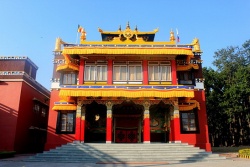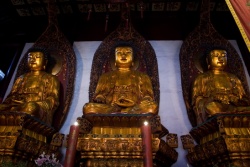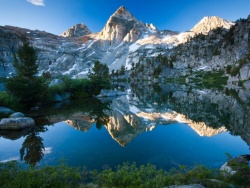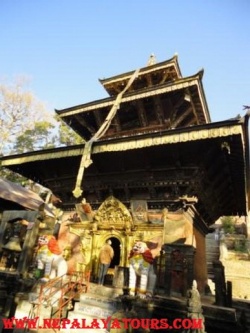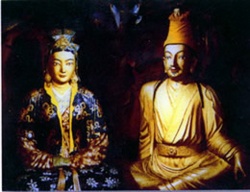Mustang
Mustang was closed to foreign visitors until 1992, and little was known about its monasteries and their art. Remote, untouched, virtually unknown, it acquired an aura of mystery, enhancing its allure. Its wall paintings were first mentioned, briefly, by the great Italian Tibetologist, Giuseppe Tucci, who was permitted to enter Mustang in 1952. (See Tucci, "Journey to Mustang," 1952.) In the 1960s, it served as a base for the Khampa rebels, Tibetan fighters who were engaged in a futile struggle against the Chinese occupation. (The Khampas received initial support from the American CIA.) Following that period, the government of Nepal kept Mustang closed because of its sensitive border location. When Mustang was finally opened, several conditions were imposed.
SETTING AND DAILY LIFE
Upper Mustang lies in the rain shadow of the great Himalayan wall. The monsoon rains exhaust themselves on the mountains' southern slopes, while the country on the northern side remains arid. Upper Mustang, at the edge of the Tibetan plateau, is a high altitude desert, with a landscape resembling that of the American Southwest. Its brown, sandy slopes are brightened at long intervals by patches of vivid green, the irrigated fields that mark the presence of a village.
With wood extremely scarce and precious, the houses and gompas of Mustang are made of dried mud and its capital, Lo Monthang, is no exception. Even the royal palace and the great gompas are earthen, mud-brick structures. Lo Monthang is a walled, medieval town, and its wall is earthen as well.
In many respects, life in Mustang still has a medieval or at least a pre-modern quality. A type of serfdom was abolished only late in the twentieth century. Most villages lack electricity, indoor plumbing and running water, and telephone service. Village lanes are unpaved. Houses serve as both barn or byre and also home, with animals on the ground floor and the family living above. Each morning in Lo Monthang, the animals--horses, goats, sheep--are driven out through the single gate in the town wall to graze. During the day, the villages are nearly empty: the women are in the surrounding fields, weeding and tending the crops, and the men are either out with the herds or away on trading or transport expeditions. In Lo Monthang, which has a primary school (as well as a school for novice monks), some children are at their lessons, while others are out tending herds of goats.
Lo Monthang is at 13,000 feet and Mustang's other villages are almost that high; at those altitudes, the main crops are barley, potatoes, and buckwheat. Mustard is also grown, but used mainly for oil. In late afternoon, everyone returns to town--animals stream back through the gate, children rollick in the lanes and the main square, and women gather briefly outside their houses to chat with their neighbors. Winters in Mustang are severe, and in late October or November, many people leave the region, some going to Pokhara or Kathmandu, others on trading trips, to return in April or early May to their Mustang homes.
The ancient Himalayan hill state now generally known as Mustang was, historically, an independent kingdom within the sphere of influence of the western states of Tibet. Its original name was Lo, as it is still known to its people, the Loba, who speak a dialect of Tibetan. The main seat of its rajas, or kings, now its administrative center, is the town of Monthang (sometimes spelled Manthang), now often referred to as Lo Monthang. The name "Mustang" is a derivation of that word, apparently a Nepali or perhaps a British mispronunciation, unrelated to the name of a certain type of horse.
Much of the geographic territory now recognized as Nepal formerly consisted of a number of small hill states and petty kingdoms, the state of Lo among them. Lo was the gateway to one of the easier pass routes to Tibet, and its kings grew rich collecting taxes on the trade of salt and wool from Tibet, and tea, rice, and other goods from what is now southern Nepal and from India.
In the late eighteenth century, Lo fell to a neighboring state, but both were soon afterward annexed into Nepal when Prithvi Narayan Shah, king of one of the hill states, conquered the others and unified them to create the nation of Nepal. The Tibetan border is only a few miles from Lo Monthang. Safe on the Nepali side of the line, Mustang's art and culture remained unscathed during the ravages of the Chinese invasion and the Cultural Revolution.
The wealth it gained from its control of the trade route between Tibet and the south enabled the royal house of Lo to commission the building and adornment of the two great gompas, Thubchen and Jampa. For this, master artists and craftsmen, many of them Newari, were brought to Lo. The Newaris, the indigenous people of the Kathmandu Valley, were highly trained and exceptionally gifted, famous for their skill in painting, carving, building, and metalwork, their handiwork broadly recognized and admired throughout a wide region. They achieved a status comparable to that of Florentine artists in renaissance Europe, although Himalayan artists (Newari, Tibetan, Kashmiri, and others) did not customarily sign their work but remained almost always anonymous. (One Newari artist and designer, however, achieved exceptional personal fame: Arniko Aniko, who in the thirteenth century was brought to the court of Kublai Khan, then emperor of China, and placed in charge of the imperial craftsmen.) The artist was a medium rather than a creator, whose function was to transmit or reproduce, not invent, the correct representation of a deity. Only correct representation could serve as a passage for the true transmission of a spiritual essence.
After Lo fell to the neighboring state of Jumla, it lost its control of the trade route and the revenue of its taxes. Mustang became poor and fell into obscurity, yet paradoxically, this may have saved its art treasures. Frequently and even customarily in the Tibetan cultural world, faded gompa murals in a state of deterioration were overpainted. Mustang's later poverty may have preserved the original wall paintings.
The first modern scholar to view the paintings of Thubchen and Jampa was the great Tibetologist, Giuseppe Tucci, who was allowed to visit Mustang in 1952. He wrote of his fear that, due to their deteriorating condition, "in a few years only the ruins will remain of these imposing buildings which belong to the best period of Tibetan art." Their paintings, he wrote,
"are stricly [sic] related by style and composition to the zin k'ams `paradises' of the sKu abum (Kumbum) of Gyantse. This means that they were the work of the same schools of painting which flourished in the 15th and 16th centuries in the Sa skya monasteries, the richest and most influential, at least until then, not only in gTsan but also in the adjoining provinces." (Giuseppe Tucci, Preliminary Report on Two Scientific Expeditions in Nepal, Rome, 1956.)
Concerning the history of Lo and its two great temples, mere scraps of data have survived amid a welter of myth and legend. Of the four major schools of Tibetan Buddhism (Nyingma-pa, Sakya-pa, Kagyu-pa, and Geluk-pa), the Sakya-pa were predominant in the fourteenth and into the fifteenth centuries. (It was the Sakya-pa who converted Kublai Khan to Buddhism, in effect "taming" the Mongols.) One of the greatest of Sakya-pa lamas was Ngorchen Kunga Zangpo (in Tibetan, Ngorchen Vajradhara Kun dga' bzang po, 1382-1456), who developed the triple activity of teaching, composition and debate, and who founded the great Ngor Gompa (Ngor E-wam Chos ldan) in Tibet in 1429. Exemplifying the cloud of legend that swirls around this period, Ngorchen Kunga Zangpo's coming to Tibet was said to have been prophesied by the Buddha in several sutras. Under Ngorchen's leadership, Ngor Gompa became the pre-eminent Sakya cultural center and one of Tibet's great artistic treasures. Ngorchen apparently visited Lo three times, upon invitation from the king of Mustang.
According to Khenpo Tashi Tenzin Rinpoche, the abbot of Lo Monthang, Jampa gompa was built by King Amapal (A me dpal) and his son, A mgon tshe dbang bzang po, in accordance with instructions given by Ngorchen Kunga Zangpo.
Due to the kindness of the compassionate great Dharma king
A mgon bzang po, father and son, etc., the second Jina Vajradhara,
ngorchen Kun dga' bzang po was invited and the Great Buddha,
(Buddha) Vajradhara and the Great Maitreya temple were built.
Text in Tibetan:
bka' drin pa chos rgyal chen po A mgon bzang po yab sras mams
kyi sku drin la rgyal ba rdo rje `chang gnyis pa ngor chen kun dga' bzang po spyan drangs/thub chen rdo rje `chang byams chen gsum
gyi gtsug lag knamg bzhengs//
